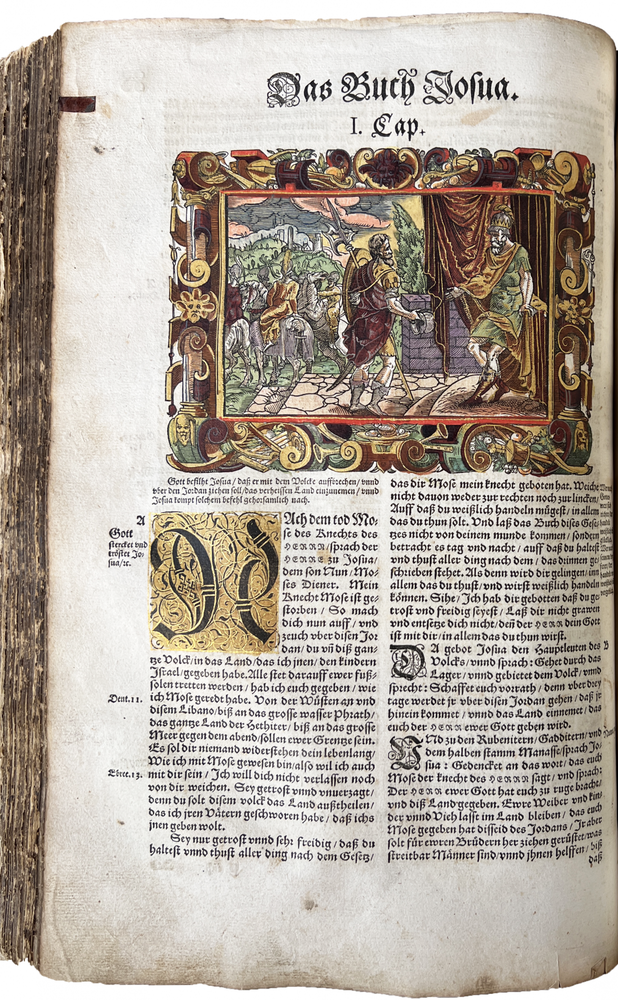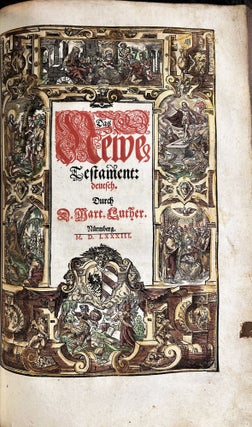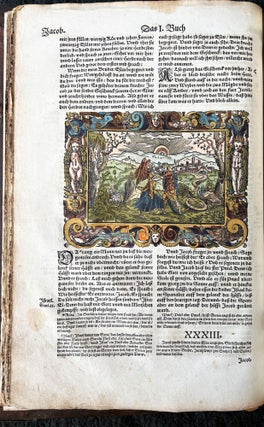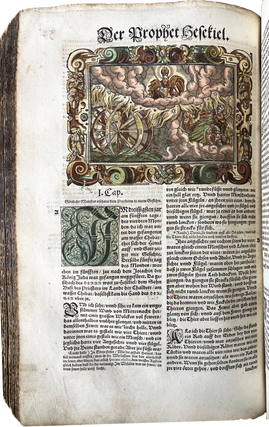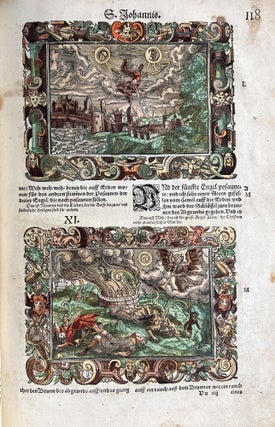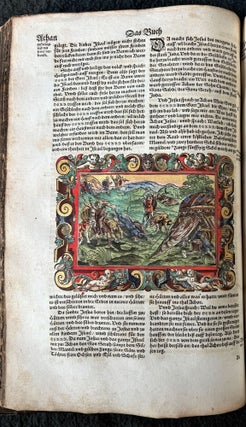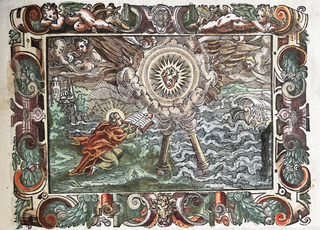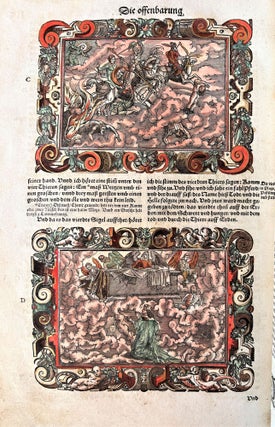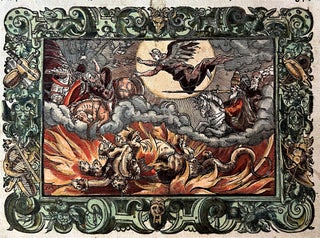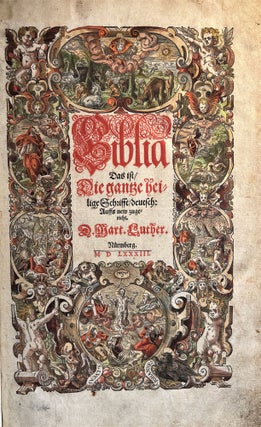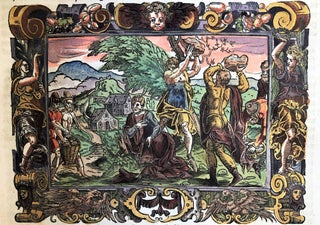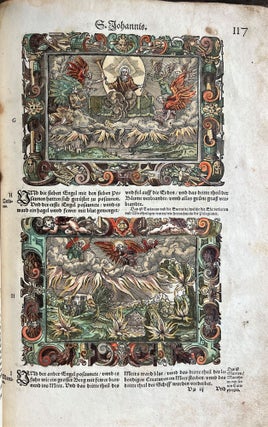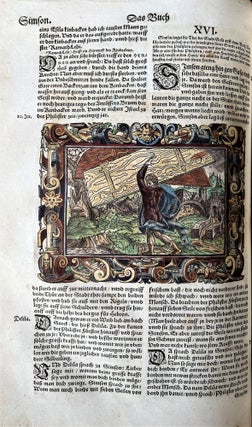Biblia, Das ist Die Gantze Heilige Schrifft deutsch: Auffs new zugericht. D. Mart. Luther. Nuremberg: (colophon:) Katharina Gerlach and Heirs of Johann vom Berg, 1583.
Three parts in one volume, folio (364 x 240 mm). [16], 262 [with errors]; 170; 127 leaves: complete. Gothic types, double column, 60/61 lines, printed shoulder notes. Partly xylographic titles, printed in red and black, the three titles set within two different allegorical title borders (parts 2 and 3 the same), the OT title by the master MF after Jost Amman, incorporating six different small scenes from respectively the Old and the New Testament, the Prophets/New Testament title by I B (Johann Bocksberger) after Virgil Solis, with five small scenes and the arms of Nuremberg; one hundred and thirty-eight large woodcut illustrations (84 x 124 mm.), printed from 131 blocks (i.e, 8 blocks repeated at least once), of which 42 or 43 blocks signed HM (or HME: 4 blocks); each illustration set within one of eight different ornamental woodcut borders with volutes, grotesques, caryatids, emblematic objects, etc. (overall size 122 x 165 mm.); woodcut tailpiece vignettes, woodcut Fraktur initials in several sizes. Title borders, woodcuts, tailpieces and the larger initials all hand-colored and delicately heightened in gold and silver paint by one or two contemporary colorists. A few leaves preserving copper-coated paper or parchment index tabs (the extending edges gone). Condition: scattered soiling throughout, occasional minor stains, first few leaves fingersoiled and frayed, first 30 leaves with dampstaining in upper inner margins, minor marginal dampstaining elsewhere. Hole to fol. z5 (Prophets fol. 137) causing loss of several words, trace of bleach? around it on recto, fols. D1 and D2 with marginal repairs, D1 with closed tear in text, tear catching a woodcut on T2v (OT f. 108), marginal tear to m6 (Prophets, 72), occasional other short marginal tears (eg f. 162), a couple of tiny wormholes in the last 2 quires, touching 14 woodcuts in the Apocalypse; occasional show-through of browns and dark greens. Bound in modern calf over earlier (the original?) wooden boards, metalwork cornerpieces with colored glass bosses, two fore-edge straps, original gauffered edges (darkened); endpapers renewed.***
Very rare illustrated edition of the Lutheran Bible, printed and published by one of the most important female printers of the early hand-press period. This Bible, and her reprint of 1589, were the largest productions of Katharina Gerlach’s long and productive career. In this copy the lavish title borders and nearly 140 woodcuts were hand-colored throughout by one or more contemporary illuminators, most likely from a Nuremberg shop of professional Briefmaler or Illuministen, who were instructed by their commissioner to be generous with the gold and silver highlights. This was a special copy, intended no doubt for presentation.
While the text is that of the standard Lutheran Bible, the woodcuts were cut for this edition. The illustrations and layout show both directly and indirectly the influence of Sigmund Feyerabend’s illustrated Bibles and Biblische Figuren and of the inescapable Feyeraband “house artists” Virgil Solis and Jost Amman. Amman, in fact, who resided in Nuremberg at the time, designed the Old Testament title border, while that of the Prophets and New Testament copies a border by Virgil Solis. The text illustrations are independent artistic productions, borrowing elements from Virgil Solis’ as well as other earlier Bible illustration series, while following the Solis / Feyerabend models in their size and use of grotesque ornamental borders.
Illustrations: Gerlach seems to have commissioned the Old Testament title border (signed at foot “I A”) directly from Jost Amman, whose initials appear at the foot, along with those of the Master MF, one of the more skilled block-cutters in the Amman entourage or workshop. Nagler identified MF, perhaps unreliably, as Lukas Mayer or Meier, reading the letters as “Meyer, Formschneider” (Die Monogrammisten IV: 1777, 2). Like all the woodcuts in this edition, the block (O’Dell title border a8) was reused by Gerlach for her second folio Bible, printed in 1589. According to Nagler, the same border was also used in Feyerabend’s 1589 folio Bible, VD 16B 2808 (we were unable to verify this as the edition is not digitized). As was customary, the wood engraver or Formschneider’s monogram (”MF,” in the lower right corner) is accompanied by an engraving knife or chisel (Schneidemesser), just visible in outline below the monogram. The border used for the Prophets and New Testament title-pages bears the initials V S [Virgil Solis] and I B, probably for Johann Bocksberger. Nagler (IV:1 954) described the border in his entry on the master I B, noting it in this 1583 edition. The block very closely copies Hollstein 15.92, a border after Solis used in Feyerabend’s 1560 Bible (VD16 B 2747); in the present block the Fama figure, Feyerabend’s device, was replaced with the arms of the city of Nuremberg. (Exemplifying the extent of copying and cross-copying, the same border was copied in reverse by Amman, and was used in his 1577 and 1583 Bibles: see border O’Dell a2.)
The woodblocks used for the text illustrations, all set within ornamental passepartout borders, follow the iconographic models of the Solis / Feyerabend illustrated German Bibles, but they largely emulate rather than imitate. While, for example, the illustrations of the Book of Revelations are free adaptations, mostly in reverse, of the Virgil Solis series (1560 and later), other cuts diverge from the Solis woodcuts, and some, in the Old Testament particularly, illustrate different scenes altogether. Forty-two or forty-three of the cuts are signed with the monogram of the still unidentified Master “HM” (one monogram is indistinct). One cut, that of Joseph before the enthroned Pharoah (OT, f. 23v), bears a very small monogram CG. Whether HM designed or cut the blocks, or both, is not clear, but it appears that more than one woodcutter, of different degrees of skill, produced the blocks. Whoever did design them borrowed from a variety of earlier woodcut Bible series. Schmidt, who knew of the series only from the Kaufmann edition of 1596 and later copies, commented on the eclecticism of the woodcuts’ sources. A few cuts, including (as noted by Schmidt) the Fall of Jerusalem cut on f. 167r, with the mysterious woman being rescued in the foreground, may have been borrowed from a non-Biblical series. Katharina Gerlach re-used the blocks in a later edition, in 1589 (VD16 B 2809), as did her grandson Paul Kauffmann in 1596 (VD16 B2827). The blocks or copies of them were used in the 17th century in Bibles printed in Lüneburg by the Stern brothers. (A full list of the woodcuts is available on request.)
The printer:
Née Bischoff (ca. 1520), Katharina Gerrlach outlived three husbands: Nicolaus Schmid (died 1540), the printer Johann vom Berg (d. 1563), and the printer Dietrich Gerlach (d. 1575). After marrying Berg in 1543, she joined the business, in partnership with Ulrich Neuber, making available to the press a property that she had inherited from her first husband, “bei dem Kalckhütten,” an address that appeared in their imprints for years. Following her husband’s death in 1564 “Katharina, Johann von Berg’s widow” was listed as printer and owner of the firm in the official Nuremberg city trade registers (Ämterbüchlein), but her name did not appear in the colophons of the books she published in 1564 and 1565 with Neuber, in which only Neuber and the heirs of Johann vom Berg were named. A year later, when she married Dietrich, his name replaced hers in the Ämterbüchlein. The partnership with Neuber ended, and the firm continued under the name of Dieter Gerlach, while she presumably continued to manage it. Finally, after his death, in 1576 she reappeared in the official registers, under her last married name (Katharina Gerlachin) as both a printer, with two typesetters, and Buchführer, or publisher. While Katharina directed the printing house she often shared the imprints with her second husband’s children, although her name appears increasingly alone from around 1585. VD16 lists over 350 editions bearing her imprint, including a majority of musical works. She was the most important publisher of music, notably of foreign composers and of vernacular and secular music, in the German speaking lands, and “one of the most prolific music printers of the 16th century” (Jackson). She published a type specimen (Schriftmusterblatt), including Greek types, and a Greek Bible in 1584. After her death in 1591 the Officina Gerlachin was continued by her grandson Paul Kauffmann.
The coloring:
The palette of the wash and bodycolor (or gouache) coloring is largely though not entirely dominated by greens and dark ochres, with smoky blues, browns and yellows; this rather autumnal palette was not uncommon in German coloring of the late 16th century. Differing color styles and quality of the coloring point to the likelihood that it was the work of more than one professional Briefmaler, probably two artisans working in the same shop. The coloring of the cuts in the first part, for example, appears more careful than that in the early parts of the New Testament, and in the NT overall there is more use of silver (some of which may have tarnished). The final Book of Revelation goes out in a blaze, with 26 woodcuts (letter-keyed to the text) in 24 pages, dramatically colored in pinks and greens. Throughout the book details of clothing, outlines, and shading are supplied in gold and in silver (the latter used most effectively in scenes of water, such as that of Jonah emerging from the whale [Prophets, f. 96r]). Nuremberg was the home of the distinguished Mack family of colorists, and the city’s archival records show their domination of the local trade. These records have also permitted historians to reevaluate the long neglected role of professional colorists. “The print-coloring professions were practiced throughout Germany ... the business of coloring prints flourished from the late fifteenth through the seventeenth century” (Dackermann, pp. 19-20). While the Macks signed their splendid work with monograms, our more humble colorists remain anonymous.
Rarity: VD 16 lists a single institutional copy, in the Württembergischen Landesbibliothek in Stuttgart; it is uncolored. Two other copies, of which one colored and in poor condition, have appeared at auction in the past half century. Darlow & Moule list none of the three Officina Gerlach editions. Both the Gerlach 1589 and Kaufmann 1596 editions are nearly as rare as the present edition, VD16 listing two copies of each. There appear to be no copies of any of these editions in American libraries.
References: VD16 ZV 1512. Nagler, Monogrammisten III:1954 (p. 815-816) and III:1251 (p. 494-497); P. Schmidt, Die Illustration der Lutherbibel 1522-1700, pp. 301-3 (1596 edition); Ilse O’Dell, Jost Ammans Buchschmuck-Holzschnitte für Sigmund Feyerabend (Wiesbaden 1993). On Gerlach, see Reske 761-2 & 738; Benzing 361 (under Dietrich Gerlach...); Grieb, Nürnberger Künstlerlexikon (2007) I:464; Jackson, art. Gerlach, Oxford Music Online; E. Hanisch & F. Willasch, “Frauen in einer Männerdomäne – Druckerinnen im 16. Jahrhundert?,” Staatsbibliothek zu Berlin., online blog. Item #3207
No longer available

